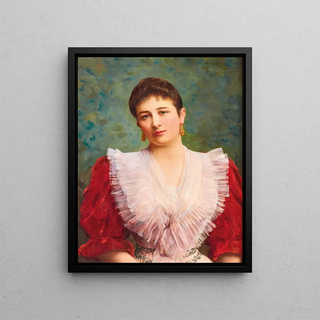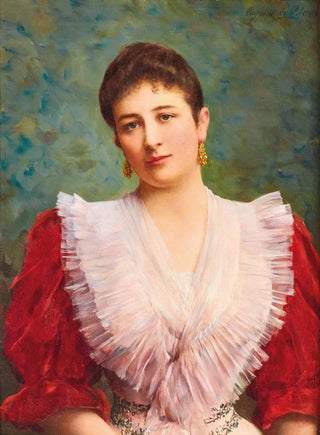Painting Portrait of Olga Sardegna Daverio - Eugen von Blaas | Art print


View from behind

Frame (optional)
Portrait of Olga Sardegna Daverio - Eugen von Blaas – Captivating Introduction
The "Portrait of Olga Sardegna Daverio" by Eugen von Blaas is a work that transcends the simple frame of an artistic representation to become a true window into the soul of its model. This painting, which captures Olga's elegance and psychological depth, evokes not only physical beauty but also the richness of her character. In this artwork, every brushstroke seems to tell a story, that of a woman whose gaze, both gentle and penetrating, invites contemplation. The art print of this portrait brings a touch of sophistication to any space, while celebrating the artistic heritage of an era when portraiture was a means of immortalizing prominent figures of society.
Style and uniqueness of the work
Eugen von Blaas, renowned for his mastery of portraiture, deploys here a style that combines realism and romanticism. Light plays a crucial role in this piece, illuminating Olga's face and creating a striking contrast with the background. The meticulous details of her dress, with its delicate textures, testify to a particular attention to materials and light effects. The color palette, soft and harmonious, enhances the serenity of the composition while highlighting Olga's facial features. The pose chosen by the artist, both natural and posed, reinforces the impression of intimacy, as if the viewer is invited to share a privileged moment with the model. This portrait does not merely depict a woman; it captures an essence, a frozen moment in time, which continues to fascinate entire generations.
The artist and his influence
Eugen von Blaas, born in Venice in 1843, established himself as one of the most influential artists of his time. Trained at the Venice Academy of Fine Arts, he developed a unique style that blends the tradition of classical portraiture with contemporary elements. His work is marked by a deep understanding of human psychology, allowing him to create portraits of rare emotional intensity. Blaas was also influenced by the Pre-Raphaelite movement, whose themes of beauty and the female ideal

Matte finish

View from behind

Frame (optional)
Portrait of Olga Sardegna Daverio - Eugen von Blaas – Captivating Introduction
The "Portrait of Olga Sardegna Daverio" by Eugen von Blaas is a work that transcends the simple frame of an artistic representation to become a true window into the soul of its model. This painting, which captures Olga's elegance and psychological depth, evokes not only physical beauty but also the richness of her character. In this artwork, every brushstroke seems to tell a story, that of a woman whose gaze, both gentle and penetrating, invites contemplation. The art print of this portrait brings a touch of sophistication to any space, while celebrating the artistic heritage of an era when portraiture was a means of immortalizing prominent figures of society.
Style and uniqueness of the work
Eugen von Blaas, renowned for his mastery of portraiture, deploys here a style that combines realism and romanticism. Light plays a crucial role in this piece, illuminating Olga's face and creating a striking contrast with the background. The meticulous details of her dress, with its delicate textures, testify to a particular attention to materials and light effects. The color palette, soft and harmonious, enhances the serenity of the composition while highlighting Olga's facial features. The pose chosen by the artist, both natural and posed, reinforces the impression of intimacy, as if the viewer is invited to share a privileged moment with the model. This portrait does not merely depict a woman; it captures an essence, a frozen moment in time, which continues to fascinate entire generations.
The artist and his influence
Eugen von Blaas, born in Venice in 1843, established himself as one of the most influential artists of his time. Trained at the Venice Academy of Fine Arts, he developed a unique style that blends the tradition of classical portraiture with contemporary elements. His work is marked by a deep understanding of human psychology, allowing him to create portraits of rare emotional intensity. Blaas was also influenced by the Pre-Raphaelite movement, whose themes of beauty and the female ideal
12,34 €






